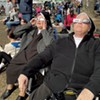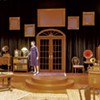Published October 22, 2003 at 3:42 p.m.
Winooski is the new Brooklyn -- I'm not sure where I heard that catchy phrase, but it's been stuck in my head for months. The implication is that Winooski is to Burlington as Brooklyn is to Manhattan -- smaller, cheaper, edgier, less gentrified but no less distinct than the bigger burg it abuts. There's even a bridge between them.
The idea, as I understand it, is not so much that Winooski is exactly like Brooklyn -- clearly the Little Onion is smaller and more provincial. It's that Winooski is the way Brooklyn was 20 or 30 years ago, full of rough edges, but poised for some polishing: a diamond in the rough.
Originally part of Colchester, the one-square-mile city declared its independence in 1922. For years it was home to woolen mills that created jobs and attracted hundreds of mostly French-Canadian and European immigrants to the area, giving Winooski its trademark Democratic, Cath-olic, blue-collar identity. But the last of the mills closed in 1954; Winooski has been struggling ever since.
Vermont historian Vincent Feeney chronicles the city's progress -- or lack thereof -- in his 2002 book The Great Falls on Onion River: A History of Winooski, Vermont. Though he concedes the past half-century has been a turbulent time for the Onion City, he also suggests that Winooski is "on the verge of a leap forward." He bases this assertion on the hope that the city's ambitious redevelopment plan will succeed. Whether or not that happens, a cultural shift already seems to be underway in Winooski's neighborhoods.
Anyone who's read the classifieds lately knows that housing prices in Chittenden County have skyrocketed over the past couple of years. This trend has driven many hopeful homeowners into Win-ooski. My partner Ann-Elise and I started house hunting last fall in Burlington's Old North End, but quickly realized the futility of our task -- it's nearly impossible to buy any house in Burlington for less than $130,000. Winooski, we heard, was cheaper.
I'd always thought of Winooski as a place I drove through to get to somewhere else. As one of Chittenden County's outlying communities, it's been overshadowed by Essex and South Burlington, which have better schools, and Colchester and Williston, which boast newer houses and more land. But one night Ann-Elise and I looked around Winooski and liked what we saw: houses of varying shapes and sizes, holiday decorations, sidewalks, people walking their dogs at night, all within walking distance of a real, Starbucks-free "downtown."
We also saw plenty of "for sale" signs. I figured it indicated a booming real-estate market. But the housing turnover also indicates another trend. Members of the older generation -- men and women who worked in the mills, whose families have anchored the city's cultural and civic life for generations -- are slowly vanishing from Winooski.
"I think the old, loyal Winooskiites are passing away," Feeney writes in an email. "They were once what made the city unique: Catholic in religion, ethnic in background -- French-Canadian, Irish and then a smattering of everything else -- and blue collar. But as their sons and daughters have moved up the socio-economic ladder they have moved out of Winooski, often to places like Colchester and Burlington."
Winooski's mayor, Clement Bissonette, has also noticed the change. "When I first ran for City Council in 1970, I could stand outside the polls and know 70 percent of the people by name," he tells me. "Now if I know 30 percent, that's a lot." These old Winooskiites are being replaced with younger, first-time homebuyers like Ann-Elise and me.
By January of this year, we had closed on a two-story brick house with three bedrooms, one bathroom, and a small fenced-in backyard for $118K -- unheard of in Burlington. The seller, a woman who bought the house in 1995, assured us that we'd be living among people who'd lived in Winooski all their lives. But six months later, the house directly across the street went up for sale. The owner's husband died this past spring, and she's moved to a nursing home. Her sister-in-law, Jan Pickering, and Jan's husband Steve still live in the house next door.
One morning I cross the street to ask Jan and Steve if they think Winooski is the new Brooklyn. They say they're not sure about that, but they are sure the neighborhood has changed. Jan's family came to Winooski from Quebec in the 19th century. Jan and her eight siblings grew up in her house, which she eventually bought from her dad. She says many of the homes on our block held five or more kids. They were mostly Catholic families whose kids attended St. Francis Xavier School on St. Peter Street.
Jan still sometimes attends one of the two daily masses in town; flocks of little old ladies scurry through the doors at 7:55 to make the 8 a.m. at St. Francis. Mass at the convent starts at 4 p.m. Both of Jan's kids have left Winooski, but she and her husband will hold out here as long as they can. "If you're born in this house," she tells me, "and you've lived here all your life, it's a really big thing to say you're going to move."
Winooski's original immigrants are now its old-timers. But a whole new crop of New Americans has since settled in. Made attractive by cheap housing and proximity to jobs in Burlington and at IBM in Essex, the city has long been a popular destination for refugees relocating through Vermont's Refugee Resettlement Program. Winooski -- a town of 6700 people -- has welcomed 691 people since the program's inception in 1988, and 35 new foreign-born residents in the last fiscal year.
Some of these refugees have since moved on, but many, like Vietnamese translator Loan Nguyen, have stayed. Nguyen and her husband have been in the U.S. for 10 years. She says Winooski looks like her town in Vietnam, "even though it is a little bit quieter." Though there were no Vietnamese families nearby when they bought their house, their neighbors welcomed them, she says. "My neighbors are so good, so kind," she says. "I love Winooski."
The influx of recent immigrants into Winooski is especially apparent in the city's schools. "We have the highest proportionate diversity ratio in the state," notes superintendent Ned Caron. Burlington and Brattleboro may have more kids, but Winooski's English Language Learners (E.L.L. has replaced E.S.L. as the politically correct term) make up a larger percentage of the student population. E.L.L. teachers work with 99 of the district's 845 students in grades K-12, or roughly 12 percent of the student body.
These kids come from all over the world -- Caron invites me to stop by the school sometime to take "the flag test." The gym is lined with flags from each of the student's home countries. These include Vietnam and Bosnia, but also Somalia, China, India and Congo. The school district must translate all communications home into the family's primary language. Jeannette Ruffle, one of Winooski's E.L.L. instructors, remarks that second languages are "nothing new" in Winooski, where many of the gravestones in St. Francis' cemetery are in French. "It's the demographics that are changing," she says. Today, for example, her French-speaking kids are Congolese.
Assimilating so many non-English speakers is expensive and, in the case of Winooski schools, may partly explain their substandard academic reputation. Studies have shown that it takes seven or eight years for kids to become fluent enough to study or learn in their new language. That poses a problem for immigrant students taking standardized, culturally biased tests in English when they've only been here for a few years, or even a few months. The district is so small that "if one or two of our students is not able to perform, that's going to make a big difference," Ruffle points out.
But both Ruffle and Caron see Winooski's diversity as an asset. In general, Ruffle feels, the E.L.L. students are motivated to learn. "They are an incredible influence in the classroom," she says. "They're very good role models, and they're wonderful to teach. It pulls up some of our population, even inspires them." Caron emphasizes that, in the big picture, "The educational dividend of this diverse population is huge."
Recent immigrants aren't the only people responsible for diversifying Winooski, however. For a bastion of Catholicism, Winooski seems to boast a surprisingly large ratio of queer eyes to straight guys. The government doesn't track sexual orientation and gender identity through the Census, but data show that in 2000, 300 Winooski households were headed by unmarried partners. Anecdotal evidence -- along with the discreet presence of pink triangles, rainbow flags, and Take Vermont Forward bumper stickers -- suggests that a lot these are same-sex couples.
What do the older residents think about their new gay neighbors? My palms are sweating when I ask the Pickerings what they thought about the civil-union debate. It turns out I needn't have worried. "It's their lives," says Jan. "If this is the way they want to live it, great for them." I can tell by her husband's tight-lipped smile and way he shakes his head that he's not the type to sport a "Straight But Not Narrow" bumper sticker. Still, he's willing to live and let live. "To each his own," he says.
I ask some of my queer Winooskiite friends what their experiences have been like. None of them report any problems with hostile neighbors. Romney Palmer, who bought a house on Elm Street a year ago with her partner Eve Johnson, says it hasn't been an issue. Palmer says her neighbors have surprised her, especially one older man. "He's the kind of guy I imagine would be doing 'Take Back Vermont,' but he's always telling us how nice we are."
Palmer loves Winooski -- "It's like a secret I don't want to give away," she says -- and her diverse neighborhood is one of the main reasons. A former Vermont National Guardsman, she'd been working as an airplane mechanic until she was laid off recently; Johnson is a nurse by day, D.J. "E.V." by night.
"You've got all your artist types, your blue-collar types, and your professionals hanging out here, living in the same space," says Palmer. "Our neighbors are really cool. They're not cool in the hip sense; they're cool in the sense that they bring over tomatoes or flowers. I could never see that happening where we lived before."
Johnson also praises the 'hood, though she tells me, "You have to show some initiative to get to know your neighbors." To that end, she and Palmer went door to door last December, introducing themselves and wishing the neighbors "Merry Christmas." Johnson became a member of the community newspaper The Winooski Eagle and offered to volunteer at the library, though they didn't need any extra help at the time.
According to Mayor Bissonette, Johnson is part of a larger trend of civil activism among new Winooski residents in their 20s and early 30s. Apparen-tly participation in corny-sounding community activities -- like volunteering for the city environmental or traffic safety board -- has attained a certain retro cool. Either that, or younger homeowners are figuring out that their older neighbors can't bear the burden of running the city forever. Bissonette calls this development "heartwarming." He's devoted years to Winooski politics; at $1700 a year, it's clearly a labor of love.
But not everyone has acquired a taste for the Little Onion. Priya Lapham, a marketing director who moved to Winooski from Williston last year, says she's "sketched out" by the place. "I just had my car broken into, so that kind of freaked me out," she tells me. She lost $1000 worth of CDs in the break-in, but saved her golf clubs, which she had moved inside the night before. "Now I'm always looking over my shoulder," she admits. "I wonder 'Am I living in a safe place for a single woman?'"
Lapham's concern is valid. Though the city comes nowhere near matching the crime rate of, well, Brooklyn, in many respects Winooski still lives up to its rough-and-tumble reputation. In 2002, there were 322 reported thefts in town. Women Helping Battered Women counseled 203 children and 121 women in the city.
"Before we moved in," John-son remembers, "we heard all these terrible things about Winooski -- it's run down, there are lots of poor people, lots of Welfare, it's dangerous." She says she was inclined to believe the hype one September night three weeks after they moved in. She heard a cacophony outside around, sirens blaring, people yelling. It scared her until she realized she was hearing the Winooski High School Homecoming Parade. "I thought, 'Wow, this isn't scary, this is awesome!'"
More By This Author
Speaking of...
-

The $200 Mystery: Anonymous Person Mails Cash to Multiple Winooski Residents
Apr 15, 2024 -

Standing Stone Wines Pours Affordable Flights in Winooski
Apr 9, 2024 -

Waking Windows Music and Arts Festival to Return for a 12th Year
Mar 7, 2024 -

Vermont Communities Tackle Budgets, Bridges and Bonds on Town Meeting Day
Feb 21, 2024 -

Burger Night at Winooski's Four Quarters Brewing Is a Soon-to-Be Smash
Feb 20, 2024 - More »
Comments
Comments are closed.
From 2014-2020, Seven Days allowed readers to comment on all stories posted on our website. While we've appreciated the suggestions and insights, right now Seven Days is prioritizing our core mission — producing high-quality, responsible local journalism — over moderating online debates between readers.
To criticize, correct or praise our reporting, please send us a letter to the editor or send us a tip. We’ll check it out and report the results.
Online comments may return when we have better tech tools for managing them. Thanks for reading.














































